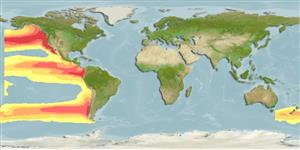>
Lampriformes (Velifers, tube-eyes and ribbonfishes) >
Trachipteridae (Ribbonfishes)
Etymology: Trachipterus: Greek, trachys, -eia, -ys = rough + Greek, pteron = wing, fin (Ref. 45335).
More on author: Kner.
Environment: milieu / climate zone / depth range / distribution range
Écologie
marin; océanodrome (Ref. 51243); profondeur 0 - 900 m (Ref. 36610). Subtropical; 60°N -
Eastern Pacific: Alaska to Chile.
Taille / Poids / Âge
Maturity: Lm ? range ? - ? cm
Max length : 183 cm TL mâle / non sexé; (Ref. 2850)
Description synthétique
Clés d'identification | Morphologie | Morphométrie
Épines dorsales (Total) : 0; Rayons mous dorsaux (Total) : 165 - 184; Épines anales: 0; Rayons mous anaux: 0; Vertèbres: 90 - 94. First 5 rays of dorsal fin greatly elongated in young becoming reduced with age, otherwise rather higher in center, extending almost to caudal and ends abruptly (Ref. 6885); caudal fin highly asymmetric, dorsal lobe becomes well developed in juveniles with 7-8 rays directed upward at an angle of 45° to body axis, and eventually with growth is much reduced; ventral lobe elongate in young specimens becoming reduced to 5-6 spines directed backward from the caudal base in older individuals; anal fin absent; pectorals small, rounded; pelvic fins elongate in young and juveniles, reduced to base in larger individuals (Ref. 6885). Juveniles iridescent silvery with a series of about 4 dark blotches spaced above lateral line canal; upright and pelvic fins carmine red; larger individuals rather very silvery and greener with light spots, around scales; posterior end of dorsal fin darker (Ref. 6885).
Oceanic (Ref. 2850). Also found near shore, but large adults sometimes feed on the bottom (Ref. 2850). Small individuals feed on copepods, annelid worms, and fish larvae; larger individuals feed on copepods, euphausiids, small pelagic fishes, young rockfishes, squid, and Octopoda (Ref. 6885). Oviparous, with planktonic eggs and larvae (Ref. 36610).
Life cycle and mating behavior
Maturité | Reproduction | Frai | Œufs | Fécondité | Larves
Eschmeyer, W.N., E.S. Herald and H. Hammann, 1983. A field guide to Pacific coast fishes of North America. Boston (MA, USA): Houghton Mifflin Company. xii+336 p. (Ref. 2850)
Statut dans la liste rouge de l'IUCN (Ref. 130435: Version 2024-2)
Menace pour l'homme
Harmless
Utilisations par l'homme
Outils
Articles particuliers
Télécharger en XML
Sources Internet
Estimates based on models
Preferred temperature (Ref.
123201): 5.9 - 10.4, mean 7.7 °C (based on 77 cells).
Phylogenetic diversity index (Ref.
82804): PD
50 = 0.5166 [Uniqueness, from 0.5 = low to 2.0 = high].
Bayesian length-weight: a=0.00102 (0.00046 - 0.00225), b=3.06 (2.88 - 3.24), in cm total length, based on all LWR estimates for this body shape (Ref.
93245).
Niveau trophique (Ref.
69278): 3.9 ±0.48 se; based on food items.
Résilience (Ref.
120179): Faible, temps minimum de doublement de population : 4,5 à 14 années (Assuming tmax>10).
Fishing Vulnerability (Ref.
59153): Very high vulnerability (90 of 100).
